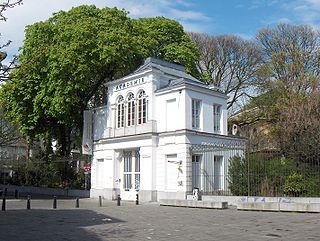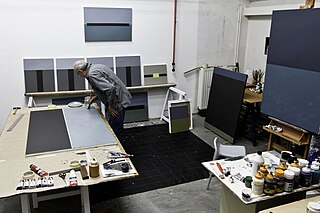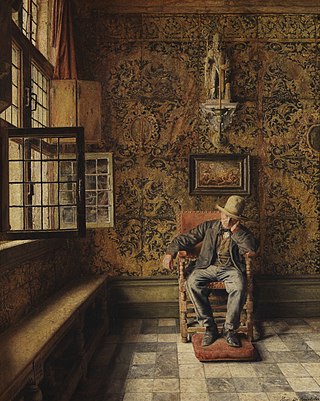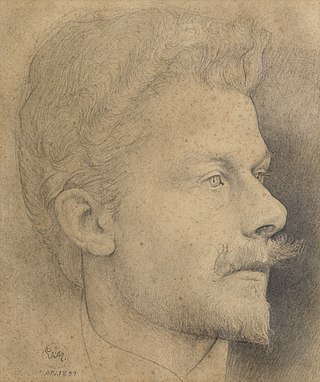Related Research Articles

Guillaume Bijl is a Belgian conceptual and an installation artist. He lives and works in Antwerp.

The Museum of Contemporary Art in Antwerp is the contemporary art museum of the city of Antwerp, Belgium. Its current director is Bart de Baere.
Kati Heck is an artist based in Antwerp. Though her work spans sculptural installation, short film, and photography, she is best known for her large-scale paintings.

Iñaki Bonillas is an artist living and working in Mexico City. His recent work is based on the photographic archive of his grandfather J.R. Plaza and family. In 2007 he participated in a group exhibition at Claremont Museum of Art.

The Royal Academy of Fine Arts Antwerp is an art academy located in Antwerp, Belgium. It is one of the oldest of its kind in Europe. It was founded in 1663 by David Teniers the Younger, painter to the Archduke Leopold Wilhelm and Don Juan of Austria. Teniers was master of the Guild of St Luke—which embraced arts and some handicrafts—and petitioned Philip IV of Spain, then master of the Spanish Netherlands, to grant a royal charter to establish a Fine Arts Academy in Antwerp. It houses the Antwerp Fashion Academy.
Museum voor Schone Kunsten may refer to:
Koen van den Broek is a Belgian artist who lives and works in Antwerp and Seoul, South Korea.
Laboratorium was a contemporary art exhibition curated by Barbara Vanderlinden and Hans-Ulrich Obrist at Fotomuseum Antwerp, the Century City building and various other locations in Antwerp, Belgium, from 27 June to 3 October 1999.

Luc Piron is a Belgian artist. He is a painter and printmaker. He is also a photographer and experiments with the possibilities of computer art.

Bart Cassiman (1961), is an international freelance-curator, art critic and editor, is an art historian and studied press- and communication sciences at the Ghent University (1979-1984).
Edith Dekyndt is a visual artist.

The Joiners' Guild Altarpiece is a altarpiece by Quentin Matsys, executed c. 1511, produced for the eponymous guild in the aftermath of its split from the Coopers' Guild in 1497. It is now in the Royal Museum of Fine Arts, Antwerp. It is sometimes also known as the Passion Altarpiece or the Martyrdom Altarpiece after the scenes of martyrdoms of John the Baptist and John the Evangelist on the side panels. Both these saints were patrons of carpenters and also appear in grisaille on the outside of the side panels. The central panel shows the Lamentation over the Dead Christ.

Philippe Vandenberg (1952–2009) was a Belgian painter.

The Parisian Sphinx is an oil-on-canvas painting by Belgian painter Alfred Stevens. Painted between 1875 and 1877, it depicts a dreamy young woman gently supporting her head with her hand. The painting is part of the permanent collection of the Royal Museum of Fine Arts in Antwerp. The Parisian Sphinx shows the influence of Vermeer and the other Netherlandish old masters on Stevens, and testifies to the Symbolist influence in the latter's day. It incorporates a harmonious juxtaposition of superficial Dutch realism with the spreading Symbolist manner, as opposed to the bottom-up, pluralistic symbolism of the declining Romanticism.

Portrait of Stephan Geraedts, Husband of Isabella Coymans is an oil on canvas painting by Dutch Golden Age painter Frans Hals. The painting was originally part of a couple of pendant wedding portraits. Hals probably painted the present portrait, Stephanus Geraerdts', alderman in Haarlem, and the accompanying portrait of the latter's wife Isabella Coymans around 1650–1652, six or seven years after their marriage in 1644. Isabella's portrait is now in a private collection in Paris.

Self-Portrait is an oil-on-canvas painting by the French Neoclassical artist Jean-Auguste-Dominique Ingres. The painting measures 25.2 x 20.9 inches and is part of the permanent collection of the Royal Museum of Fine Arts in Antwerp. This painting is one of the last portraits by Ingres.

The Preacher Eleazar Swalmius is a 1637 oil-on-canvas painting by the Dutch artist Rembrandt. It is currently owned by the Royal Museum of Fine Arts in Antwerp. The painting has been certified a real Rembrandt. The painting was listed in 1727 in the catalog of the Duke of Orléans collection, as a portrait of an Amsterdam mayor by Rembrandt. It remained in the noble family's possession until 1792, when Duke Louis-Philippe-Joseph sold the entire collection to finance his political career and pay off debts. The painting passed through several English collections into the hands of the Bourgeois brothers, art dealers from Cologne, who sold the painting as an original Rembrandt to the museum in 1886. The painting was stored away for a long time due to doubts cast over its authenticity.

The Man in the Chair is an oil on canvas painting by Belgian painter Henri de Braekeleer. The painting is currently housed at the Royal Museum of Fine Arts in Antwerp.

Charles Mertens, Karel Jozef Mertens or Karel Mertens was a Belgian draughtsman, painter, muralist, etcher and illustrator. He is known for his portraits, landscapes and genre scenes. He painted many scenes with fishermen and fishing boats.
References
- 1 2 3 4 5 6 7 8 "M HKA, Martin Douven, Leopoldsburg, Jef Geys 09.09 > 31.12.11" (PDF). 5 September 2011. Archived from the original (PDF) on 4 March 2016. Retrieved 24 June 2013.
- 1 2 3 "Jef Geys, Belgian Pavilion, 53rd International Art Exhibition – La Biennale di Venezia" (PDF). 21 April 2009. Retrieved 24 June 2013.[ permanent dead link ]
- ↑ "Afterall • Journal • The Really Ignorant Schoolmaster: Jef Geys, Amongst Many Others". afterall.org. Retrieved 30 April 2014.
- ↑ "ScherpteDiepte". journal.depthoffield.eu. Retrieved 30 April 2014.
- ↑ Jef Geys 1978, 'Letter to the Minister of Dutch Culture' (November 11, 1970), in: Ooidonk 78, exh. cat., 101.
- 1 2 3 4 Luk Lambrecht. "Belgian Pavilion: Jef Geys". Metropolis M. Archived from the original on 18 May 2013. Retrieved 23 June 2013.
- ↑ "Planted Stories: Jef Geys Touches Down in Detroit". hyperallergic.com. 27 May 2010. Retrieved 23 June 2013.
- ↑ Mike Powell (October 2010). "Frieze Magazine – Jef Geys". frieze.com. Archived from the original on 24 June 2013. Retrieved 23 June 2013.
- ↑ "Jef Geys – Retrospectieve-Introspectie" (PDF). Galerie Erna Hecey. 21 December 2007. Retrieved 24 June 2013.
- ↑ "What Are We Having for Dinner Tonight?". Witte de With. 15 October 1993. Archived from the original on 4 October 2015. Retrieved 23 June 2013.